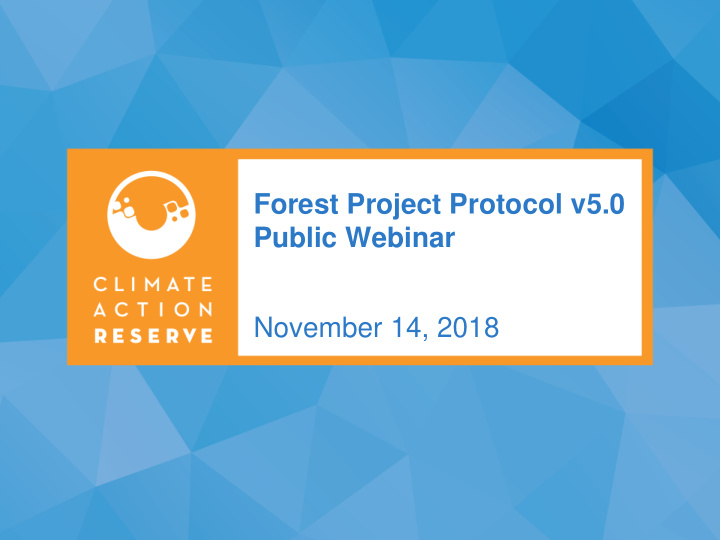



Forest Project Protocol v5.0 Public Webinar November 14, 2018
Agenda Review rationale for revision Overview of major changes Public comment timeline Q&A 2
Rationale for Revision Reducing the cost of Making the protocol Promoting voluntary project more accessible to projects implementation smaller landowners Providing an Addressing errata example of potential from FPP v4.0 and policy revisions for updating for new ARB to consider in research and future COP updates feedback 3
Overview of Changes Major revisions – New IFM Baseline Methodology – Updated IFM Secondary Effects – Reduced verification frequency for small projects, and projects not seeking CRTs – Provisional project boundary option for public Avoided Conversion projects – Separation of reforestation project type Minor updates and corrections 4
Major Revisions – New IFM Baseline Methodology • Created a methodology that would eliminate the cost of modeling for eligible IFM projects – Instead of the traditional methodology, where projects have to model a 100-year baseline with legal and financial constraints, we would provide a straightforward option using conservative assumptions • Assumptions were developed based on an analysis of current projects in the Reserve’s voluntary program, and ARB’s compliance program 5
Major Revisions – New IFM Baseline Methodology Baseline Aboveground Live Carbon in excess of Common Practice as % of Common Practice - ARB compliance projects above common practice 60 50 40 6% # of Projects 30 20 10 0 2.5% 5.0% 7.5% 10.0% 12.5% 15.0% 17.5% 20.0% 22.5% 25.0% 27.5% 30.0% 57.5% % Class (upper bound) 6
Major Revisions – New IFM Baseline Methodology • Non- modeling approach referred to in FPP v5.0 as the “standardized approach” as opposed to the “modeled approach” • New steps are: – Determine eligibility to use the standardized approach – Establish initial baseline (either Common Practice or initial carbon stocks) – Initial baseline is increased by 6% to conservatively account for legal and financial constraints – Harvest volume is estimated based on trends we’ve observed in existing carbon projects – Below ground carbon is estimated in the baseline in proportion to the initial inventory 7
Major Revisions – Eligibility for Using the Standardized Approach • Project cannot have deeded encumbrances that prevent timber management • Project must pass a screening test via a tool we have published (detailed on the next slide) • All projects have the option to model the baseline per the existing methodology – Projects that do not meet the criteria for the standardized option must model 8
9
Major Revisions – Standardized Baseline Screening Tool 10
Major Revisions – Standardized Baseline Screening Tool 11
Major Revisions – IFM Secondary Effects • Equations have been revised to clarify that credits set aside for leakage in a given year can be recouped in later years if harvesting increases relative to the baseline • The percentage of credits set aside to leakage is now variable: – Leakage percentage is the lesser of the following: 𝐵𝑑𝑢𝑣𝑏𝑚 ℎ𝑏𝑠𝑤𝑓𝑡𝑢 −𝑐𝑏𝑡𝑓𝑚𝑗𝑜𝑓 ℎ𝑏𝑠𝑤𝑓𝑡𝑢 - or - Harvesting condition variable, detailed below 𝑐𝑏𝑡𝑓𝑚𝑗𝑜𝑓 ℎ𝑏𝑠𝑤𝑓𝑡𝑢 12
Major Revisions – Verification Schedule • New verification options: Project entering a monitoring Smaller project verifications phase • All Forest Projects receiving • Any Forest Project not seeking under 4,000 CRTs/year CRTs by the time a site visit is • Changes the site visit frequency required • In such cases, they will need to from every 6 years to every 12 years have previously submitted • 4,000 CRTs are on average; site monitoring reports verified as a desk review visit is triggered if 48,000 • Decline in canopy cover of more unverified CRTs have accumulated than 5% triggers a site visit • Canopy cover now required to be submitted in project documents 13
Major Revisions – Avoided Conversion Provisional Project Boundary • Avoided Conversion projects being undertaken by a public entity may list the project with a provisional project boundary • The following conditions apply: – At least one portion of the project area must already be owned at the time of listing – The final project area must be covered by appraisals identifying a single type of anticipated conversion – The Project Operator submits a signed memorandum describing their intent to acquire the remaining portions of the provisional project boundary – No credits will be given for portions of the provisional project boundary until a final Project Area has been determined and all other requirements in the protocol have been met. 14
Major Revision - Reforestation • Reforestation has been removed from the protocol, pending future policy updates – Existing projects can continue to use the v4.0 methodology • Considering reintroducing as a standalone protocol in the future 15
Minor Revisions • Clarification around requirements for project ownership • Enhancement payment guidance • Clarified timing for natural forest management requirements • Updated quantification guidance to align with ARB’s conversion factors • Updated quantification guidance to include an example of how secondary effects are recouped in IFM projects • Corrected errata throughout the IFM quantification section in v4.0 16
Public Comment Process Documents available for Timeline public comment • Draft Forest Project • 30 day public comment Protocol v5.0 (clean and period will end on redline) 11/30/18 • Quantification guidance • Reserve will be • New Assessment Area responding to comments and drafting data file revisions through the • Standardized Baseline month of December Screening Tool • Calculation worksheet available by request 17
Climate Action Reserve Inventory Tool (CARIT) Developed with funding support from a Conservation Innovation Grant provided by the USDA NRCS To be released for public use at the same time as FPP v5.0 18
Questions? John Nickerson • Vice President, Forestry • john@climateactionreserve.org Sarah Wescott • Forest Program Manager • swescott@climateactionereserve.org Jon Remucal • Senior Forest Policy Manager • jremucal@climateactionreserve.org 19
Recommend
More recommend